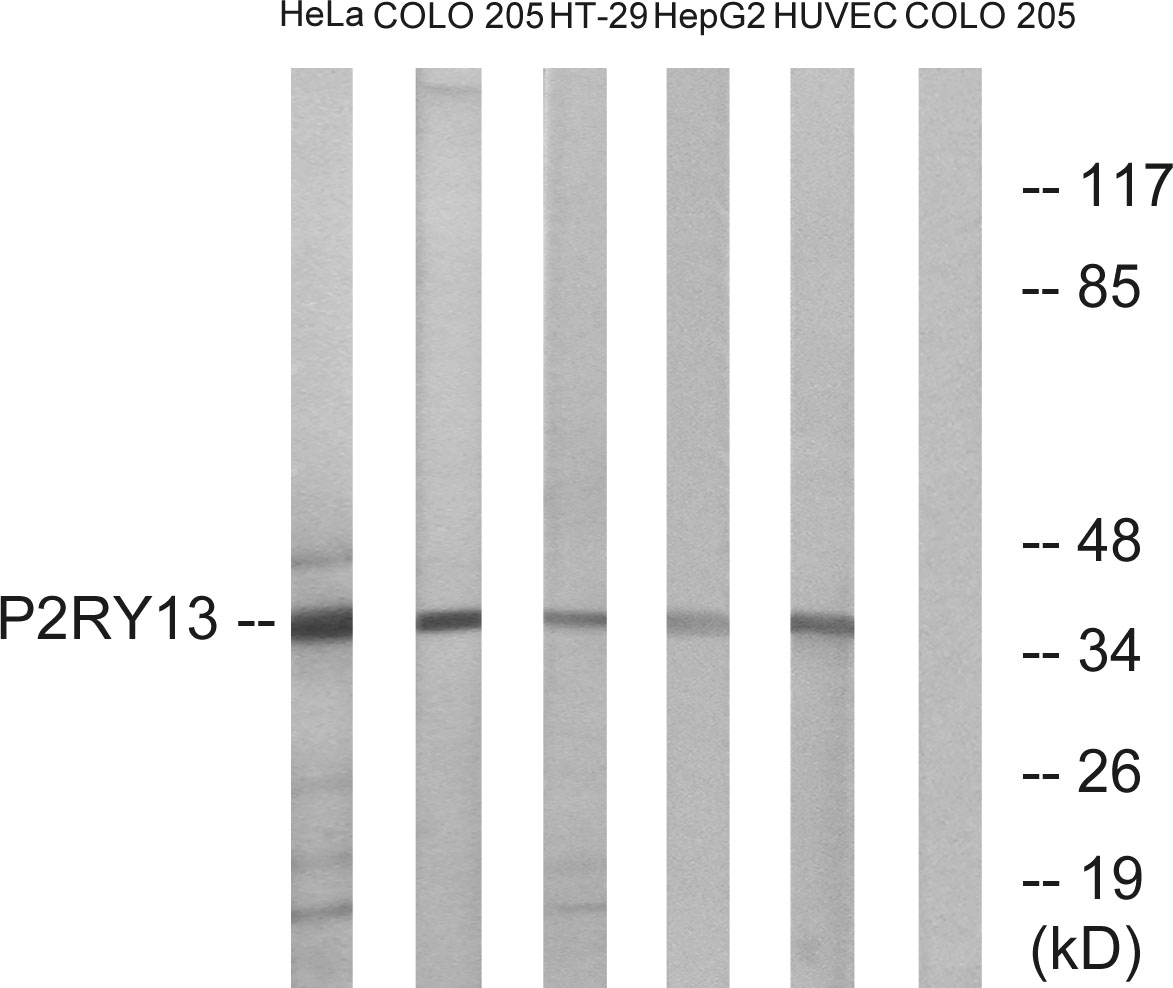产品名称
P2RY13 Rabbit Polyclonal Antibody
别名
P2RY13; GPR86; GPR94; FKSG77; P2Y purinoceptor 13; P2Y13; G-protein coupled receptor 86; G-protein coupled receptor 94
存储缓冲液
Liquid in PBS containing 50% glycerol, 0.5% BSA and 0.02% New type preservative N.
Human Gene Link
http://www.ncbi.nlm.nih.gov/sites/entrez?db=gene&term=53829
Human Swissprot No.
Q9BPV8
Human Swissprot Link
http://www.uniprot.org/uniprotkb/Q9BPV8/entry
Mouse Swissprot No.
Q9D8I2
Mouse Swissprot Link
http://www.uniprot.org/uniprot/Q9D8I2
Rat Gene Link
http://www.ncbi.nlm.nih.gov/sites/entrez?db=gene&term=310444
Rat Swissprot Link
http://www.uniprot.org/uniprot/Q6GUG4
免疫原
The antiserum was produced against synthesized peptide derived from human P2RY13. AA range:209-258
特异性
P2RY13 Polyclonal Antibody detects endogenous levels of P2RY13 protein.
稀释度
WB 1:500 - 1:2000. IHC 1:100 - 1:300. IF 1:200 - 1:1000. ELISA: 1:20000. Not yet tested in other applications.
宿主
Polyclonal, Rabbit,IgG
背景介绍
The product of this gene belongs to the family of G-protein coupled receptors. This family has several receptor subtypes with different pharmacological selectivity, which overlaps in some cases, for various adenosine and uridine nucleotides. This receptor is activated by ADP. [provided by RefSeq, Sep 2008],
组织表达
Strong expression in spleen and adult brain. Lower expression in placenta, lung, liver, spinal cord, thymus, small intestine, uterus, stomach, testis, fetal brain, and adrenal gland. Not detected in pancreas, heart, kidney, skeletal muscle, ovary or fetal aorta. Clearly detected in lymph node and bone marrow, weakly detected in peripheral blood mononuclear cells (PBMC) and in peripheral blood leukocytes (PBL), but not detected in polymorphonuclear cells (PMN). In the brain, detected in all brain regions examined.
细胞定位
Cell membrane; Multi-pass membrane protein.
信号通路
Neuroactive ligand-receptor interaction;
功能
function:Receptor for ADP. Coupled to G(i)-proteins. May play a role in hematopoiesis and the immune system.,miscellaneous:Stimulation by ADP in stably transfected CHO cells resulted in inhibition of adenylyl cyclase and the phosphorylation of the MAP kinases MAPK3 and MAPK1 in a pertussis toxin-sensitive way. Inhibition of adenylyl cyclase and phosphorylation of the MAP kinases are transduction mechanisms that involve G(i) proteins.,sequence caution:Contaminating sequence. Potential poly-A sequence.,similarity:Belongs to the G-protein coupled receptor 1 family.,tissue specificity:Strong expression in spleen and adult brain. Lower expression in placenta, lung, liver, spinal cord, thymus, small intestine, uterus, stomach, testis, fetal brain, and adrenal gland. Not detected in pancreas, heart, kidney, skeletal muscle, ovary or fetal aorta. Clearly detected in lymph node and bone marrow, weakly detected in peripheral blood mononuclear cells (PBMC) and in peripheral blood leukocytes (PBL), but not detected in polymorphonuclear cells (PMN). In the brain, detected in all brain regions examined.,
纯化
The antibody was affinity-purified from rabbit antiserum by affinity-chromatography using epitope-specific immunogen.

